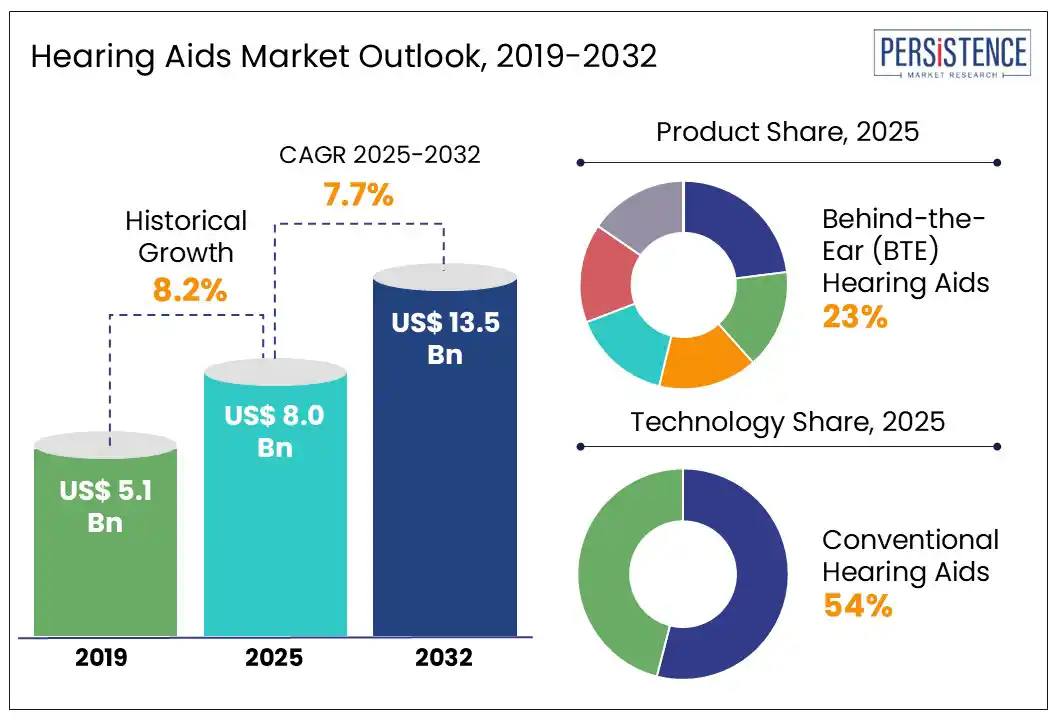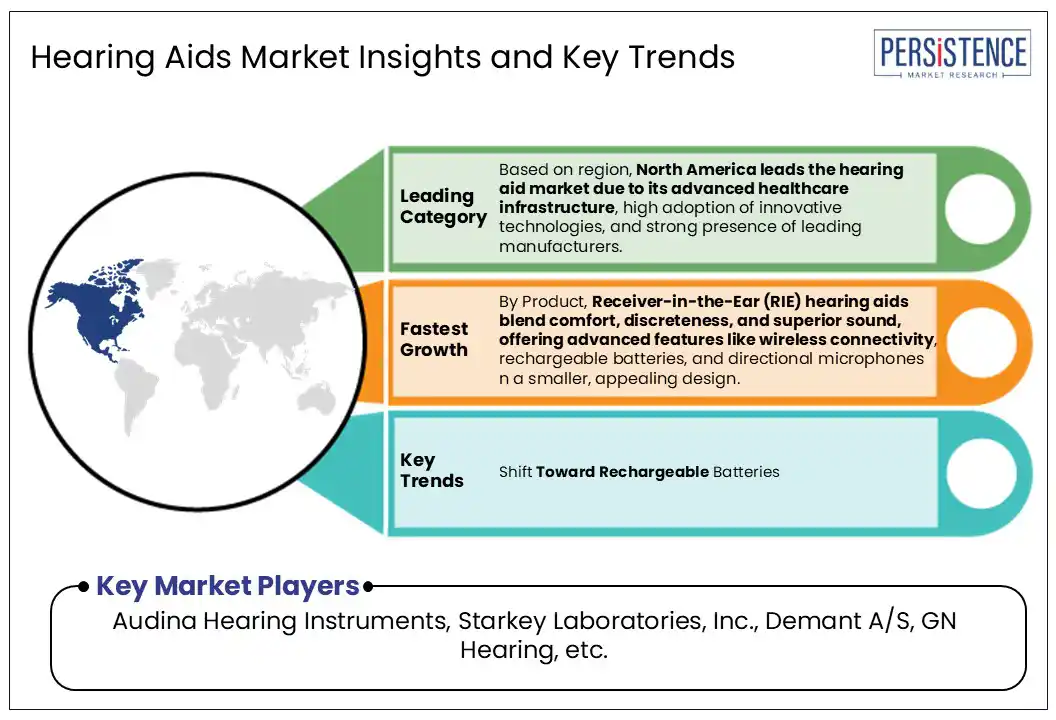ID: PMRREP4414| 192 Pages | 10 Jul 2025 | Format: PDF, Excel, PPT* | Healthcare

The global hearing aids market size is likely to be valued at US$ 8.0 Bn in 2025 and is expected to reach US$ 13.5 Bn by 2032, growing at a CAGR of 7.7% from 2025 to 2032.
The hearing aids market is witnessing steady growth, driven by rising cases of hearing loss due to aging population, noise pollution, and increased awareness about auditory health. Technological advancements such as AI-enabled devices, rechargeable batteries, and Bluetooth connectivity are transforming hearing aids from simple amplifiers to sophisticated wearable technology. Demand is further supported by improved access to hearing care services and favorable reimbursement policies in developed markets. Meanwhile, emerging economies are showing untapped potential due to growing healthcare investments and better affordability of advanced devices.

Key Industry Highlights:
The regulatory push for over-the-counter (OTC) hearing aids has redefined market dynamics by removing long-standing access barriers for millions of people with mild-to-moderate hearing loss. Traditionally, hearing aids required a medical exam, prescription, and professional fitting, deterring many due to high costs and social stigma. The FDA’s landmark ruling in 2022 allowing OTC sales empowers consumers to buy affordable, self-fitting devices directly from pharmacies, retail stores, or online platforms without involving audiologists for every adjustment. This democratization of hearing care reduces costs but also encourages innovation, as tech companies and consumer electronics brands enter the market with user-friendly designs and smartphone-enabled customizations. As public awareness grows, OTC hearing aids are shifting from seen purely as medical devices to becoming lifestyle tech products that blend seamlessly with wearables. This regulatory shift is expected to accelerate market penetration, particularly among underserved population and tech-embracing younger demographics.
Social stigma related to hearing aids remains a significant barrier restraining the global hearing aids market. Despite technological advancements making devices smaller and more discreet, many people still associate hearing aids with aging, disability, or weakness. This perception discourages younger adults and working professionals from seeking help, even when they experience early signs of hearing loss. Many potential users fear that wearing a visible device might draw unwanted attention or lead to social discrimination. In some cultures, discussing hearing loss is perceived as a taboo. As a result, a large population chooses to tolerate mild to moderate hearing difficulties. This stigma-driven reluctance limits market growth, lowers adoption rates, and increases the burden on families and healthcare systems to manage untreated hearing loss.
The hearing aids market is witnessing a significant shift with the rising adoption of smart hearing aids that go far beyond basic sound amplification. Today’s consumers, especially younger and tech-savvy adults with mild hearing loss, increasingly prefer discreet, app-controlled devices that integrate with smartphones, TVs, and other IoT devices. Smart hearing aids offer advanced features such as Bluetooth streaming, AI-driven sound environment adaptation, live language translation, and remote adjustments via teleaudiology. This technological leap enhances user convenience, improves social participation, and reduces the stigma often linked to traditional bulky hearing aids. Manufacturers tapping into this trend can differentiate their offerings by bundling hearing wellness with lifestyle benefits. Additionally, integration with health monitoring, such as step counters, heart rate sensors, or fall detection positions smart hearing aids as multifunctional wearables. As connectivity ecosystems expand, the smart hearing aid segment opens new revenue streams and cross-industry partnerships, driving premium adoption globally.
Behind-the-Ear (BTE) hearing aids command the largest market share because they combine versatility, power, and user-friendliness. Their design accommodates stronger amplifiers and larger batteries, making them effective for mild to profound hearing loss. BTEs easily integrate smart features like wireless streaming and directional microphones, appealing to tech-savvy users. They’re favored by audiologists for children due to safety and easy adjustments. Elderly users appreciate their simple handling and durability. BTEs also allow custom earmolds for a secure, comfortable fit and better sound quality. Their adaptability, cost-effectiveness in fittings, and consistent innovation keep them in demand globally, cementing BTEs as the preferred choice in clinics and hearing care centers.
Digital hearing aids dominate the market because they seamlessly blend advanced signal processing with user-friendly features that transform hearing care. Unlike conventional analog aids, digital devices precisely analyze and adapt sounds to individual hearing profiles, offering clearer speech, reduced background noise, and connectivity to smartphones and TVs. This technology appeals to modern consumers seeking comfort, discreet designs, and smart integration. Falling microchip costs and rising awareness have made digital hearing aids accessible even in emerging markets. Additionally, audiologists and manufacturers favor digital models for their programmability and upgradability, ensuring tailored long-term solutions for diverse hearing needs.
Audiology clinics dominate the hearing aid market because they offer comprehensive, trusted services that go beyond simply selling a device. Patients rely on certified audiologists for accurate hearing assessments, personalized fitting, and ongoing adjustments, critical for devices that require precise calibration. Clinics also provide counseling, maintenance, and warranty support, which builds confidence and loyalty among users, especially elderly patients who value expert guidance. Manufacturers often collaborate directly with clinics to ensure their products reach the right users with proper aftercare. Unlike retail or online stores, clinics foster long-term patient relationships, making them the preferred channel for purchasing premium, medically necessary hearing aids, thereby capturing the largest market share in this highly specialized segment.

Hearing loss remains a significant health concern in North America, shaping steady growth in the region’s hearing aids market. As per the National Institute on Deafness and Other Communication Disorders, nearly one in eight Americans, about 13% of those aged 12 and above, experience hearing loss in both ears. This challenge extends to younger generations, too, with 2 to 3 out of every 1,000 children in the U.S. born with measurable hearing impairment. An estimated 30 million American adults could benefit from hearing aids, yet many remain untreated. Rising awareness, an aging population, and expanding access through audiology clinics and advanced devices are driving demand, positioning North America as a leading hub for hearing aid innovation and adoption.
Europe’s hearing aids market is witnessing steady expansion driven by its rapidly aging population and strong public healthcare support. Countries like Germany, the UK, and the Nordics have robust reimbursement policies, encouraging early adoption of hearing aids among seniors. The region also benefits from a high level of awareness and regular hearing screenings, often covered by national health systems. Rising noise pollution in urban areas and increased detection of mild-to-moderate hearing loss in younger adults are further boosting demand. Additionally, Europe is seeing growing interest in discreet, tech-enabled devices integrated with Bluetooth and AI features. Local manufacturers and global leaders alike are investing in R&D and expanding audiology networks, reinforcing Europe’s position as an advanced, patient-centric hearing care market.
The Asia Pacific hearing aids market is evolving rapidly, fueled by a huge, underserved population and growing awareness about hearing health. Countries such as China, India, and Japan are witnessing a surge in age-related hearing loss cases as life expectancy rises. Unlike Western regions, access barriers such as limited rural audiology services and affordability challenges have traditionally slowed adoption, but this is changing with expanding outreach programs and government initiatives. Rising disposable incomes and urbanization are boosting demand for advanced digital hearing aids, while local players and international brands are investing in affordable models to tap price-sensitive consumers. The rise of e-commerce and tele-audiology is further transforming access, making Asia Pacific the fastest-growing market in the hearing aids market.
The global hearing aid market competitive landscape is shaped by a blend of established global giants and agile innovators. Major players like Sonova, Demant, and GN Store Nord dominate through cutting-edge technology, extensive audiology networks, and strategic acquisitions. Start-ups and regional brands are gaining traction by introducing affordable, user-friendly models targeting untapped rural and emerging markets. Competition is intensifying as tech companies enter the space with smart, app-connected hearing solutions.
The global hearing aids market is estimated to increase from US$8.0 Bn in 2025 to US$13.5 Bn in 2032.
The global hearing aids market is being propelled by the rising prevalence of hearing loss driven by aging populations and noise exposure, fueled by increased awareness and early diagnosis efforts.
The market is projected to record a CAGR of 7.7% during the forecast period from 2025 to 2032.
The hearing aids market holds promising opportunities driven by rapid technological advancements, rising demand for smart and invisible devices, and growing awareness about hearing health. Untapped rural markets and emerging economies present significant expansion prospects, especially with tele-audiology and online sales channels bridging accessibility gaps.
North America dominates the global market.
|
Report Attribute |
Key Insights |
|
Hearing Aids Market Size (2025E) |
US$ 8.0 Bn |
|
Market Value Forecast (2032F) |
US$ 13.5 Bn |
|
Projected Growth (CAGR 2025 to 2032) |
7.7% |
|
Historical Market Growth (CAGR 2019 to 2024) |
8.0% |
|
Historical Data/Actuals |
2019 - 2024 |
|
Forecast Period |
2025 - 2032 |
|
Market Analysis |
Value - US$ Bn |
|
Geographical Coverage |
|
|
Segmental Coverage |
|
|
Competitive Analysis |
|
|
Report Highlights |
|
|
Customization and Pricing |
Available upon request |
By Product Type
By Technology
By Sales Channel
By Region
Delivery Timelines
For more information on this report and its delivery timelines please get in touch with our sales team.
About Author